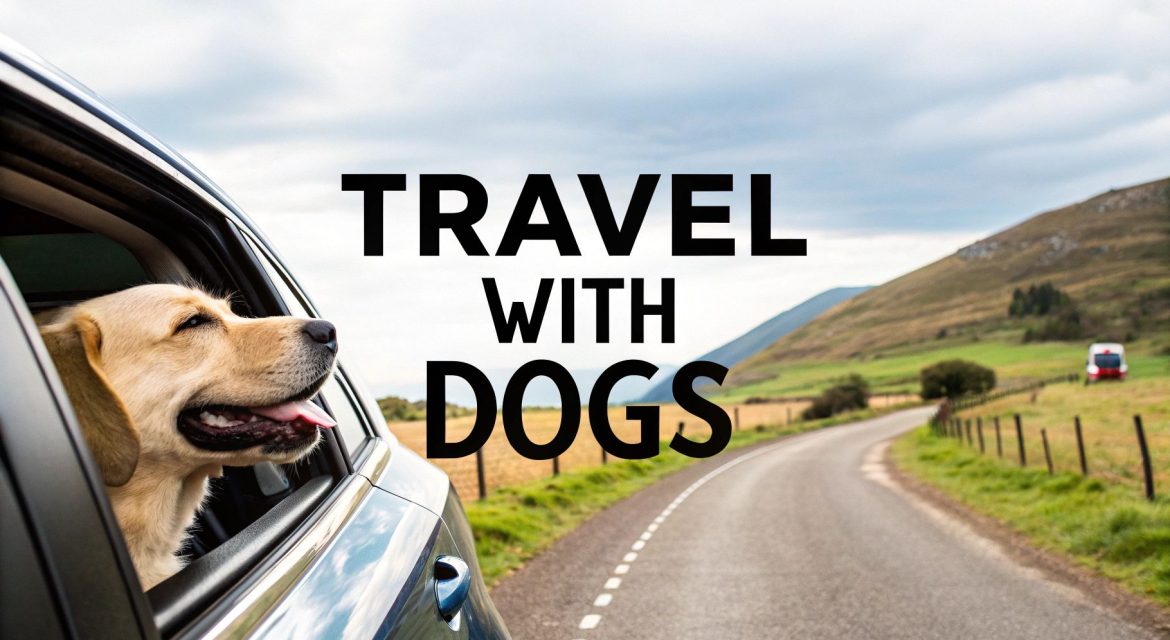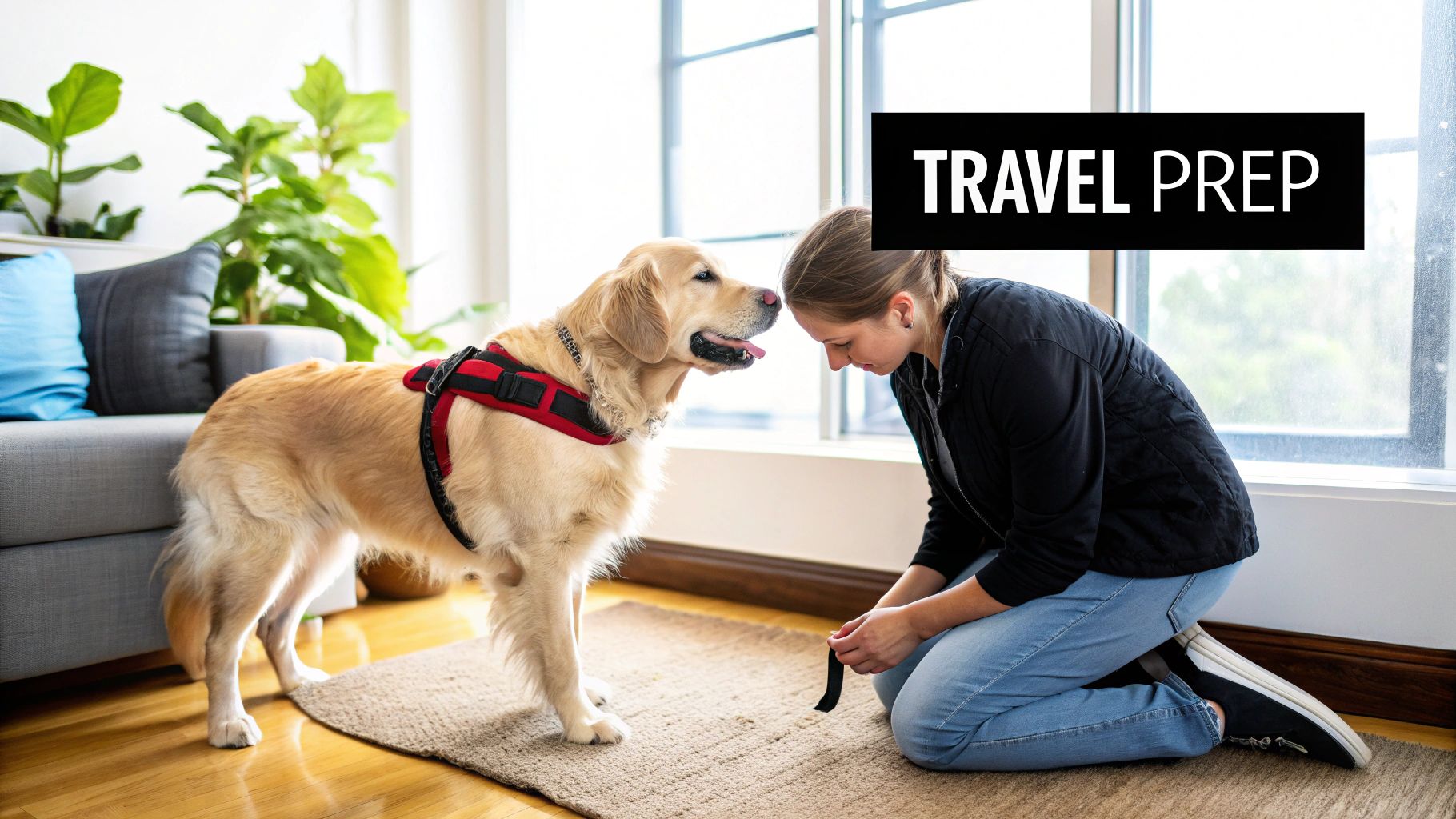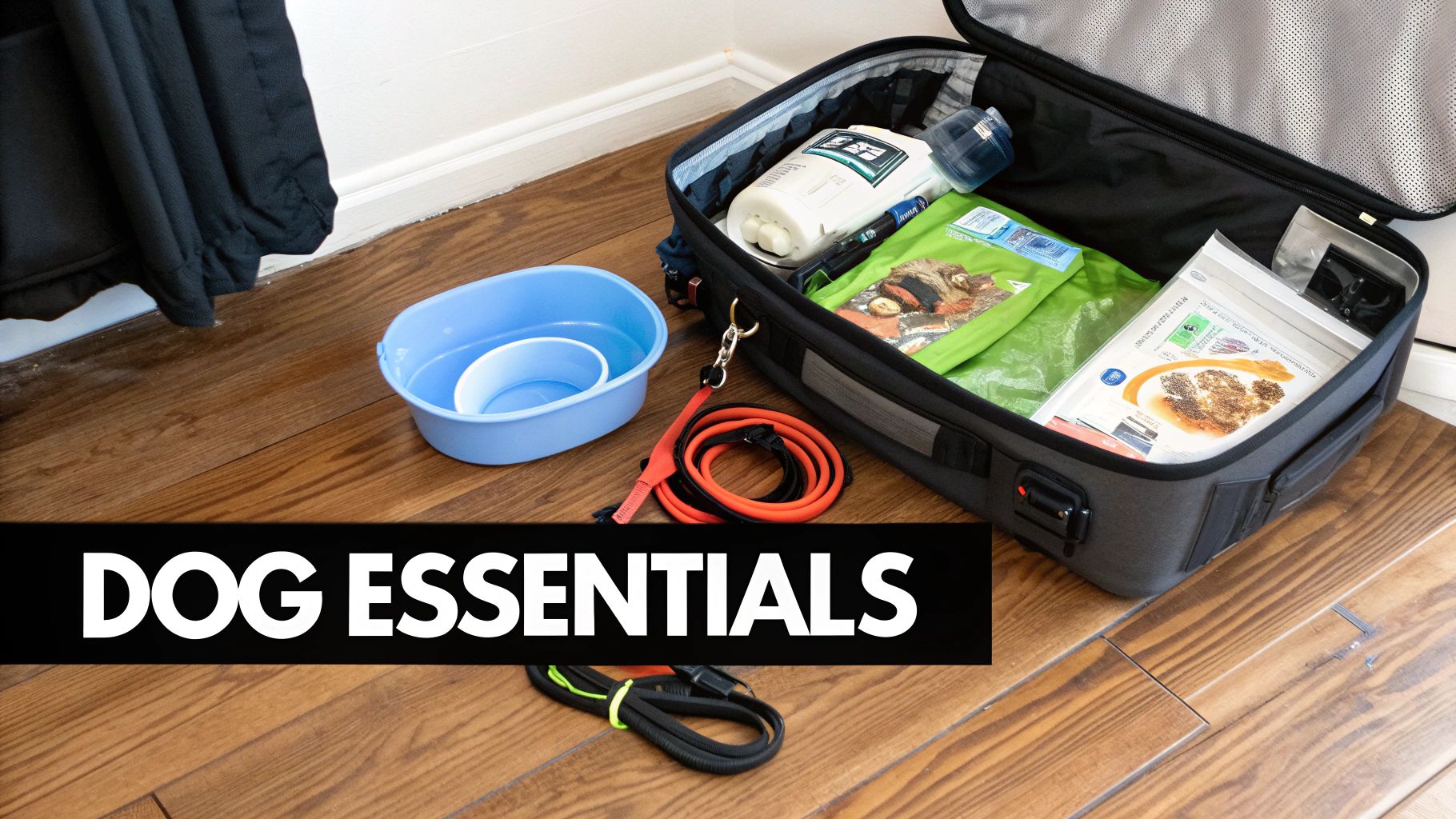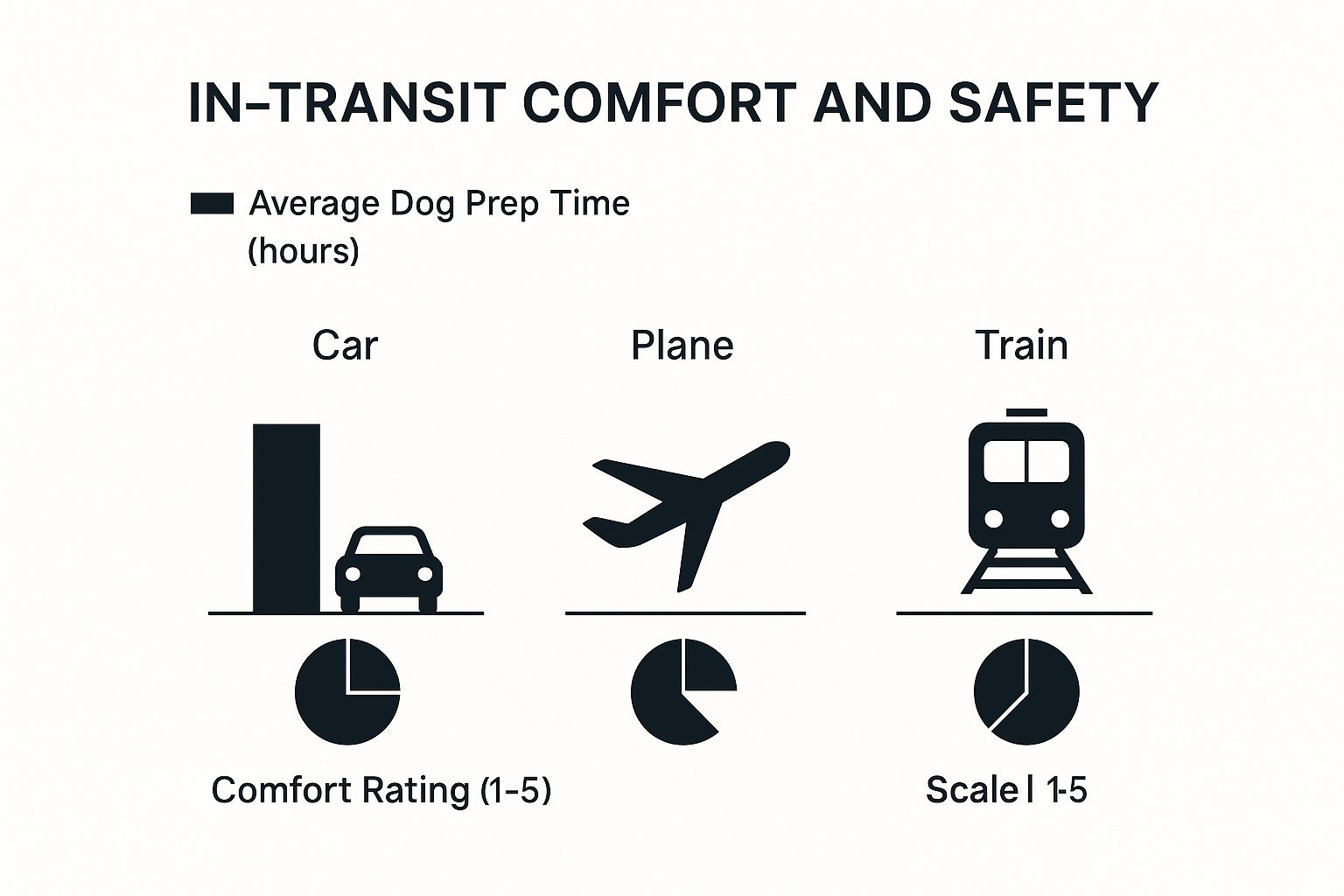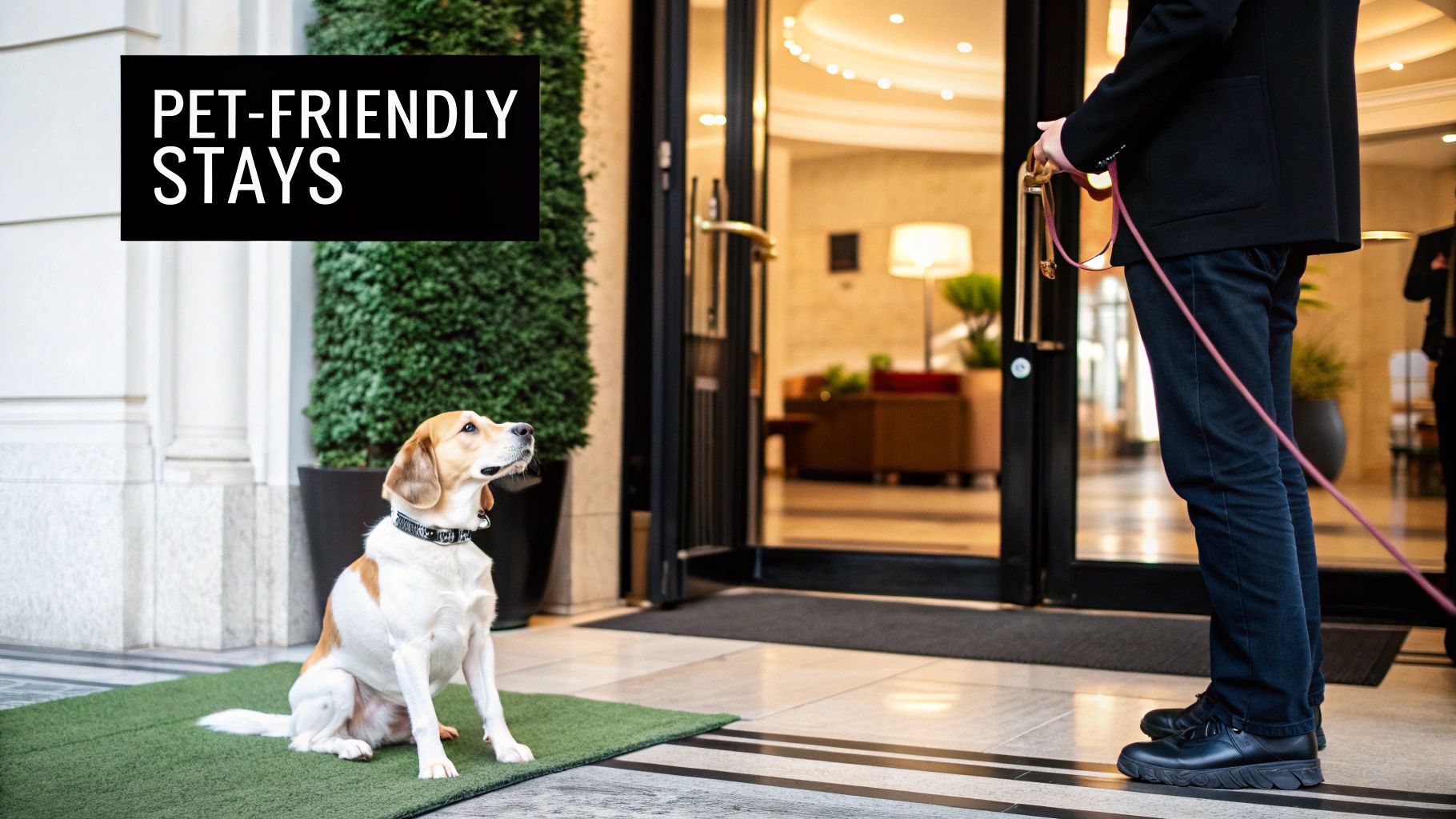Taking your dog on holiday is one of life's great joys, but a truly successful trip starts long before you pack the car. It's all about thoughtful, empathetic planning. This means choosing a genuinely dog-friendly destination, preparing your furry friend for the new experience, and keeping their comfort and safety front and centre. Get this right, and we're all set for a stress-free adventure.
Your Adventure Begins with Smart Planning
Let’s be honest, the thought of hitting the road with your best mate is exciting. Sharing a new hiking trail or just chilling together after a long day of exploring—that’s what makes lasting memories. We get it. That bond is special, and it just feels right to include them in your plans.
It seems we're not alone. A whopping 85% of dog owners in the UK now choose a staycation with their pets over jetting off abroad without them. This shift really highlights how much our dogs have become irreplaceable members of the family.
But turning that lovely idea into a smooth, happy reality takes a bit of work upfront. It’s about more than just booking a place and crossing your fingers. You need to create an experience that’s as wonderful for your dog as it is for you.
Choosing a Truly Dog-Friendly Destination
First things first: you need to find a destination that doesn't just tolerate dogs but actively welcomes them. Trust us, there’s a massive difference. A truly dog-friendly spot is one where your pup's needs are woven into the local culture.
So, what should you be looking for?
- Accessible Vets: Knowing where the nearest vet is brings incredible peace of mind. Before you book anywhere, do a quick search for local clinics and, importantly, their emergency hours.
- Welcoming Pubs and Cafes: A trip to a cosy local pub is a British holiday staple. Check for places that are happy to have dogs inside on a rainy day, not just in the beer garden.
- Year-Round Beach Access: Many popular beaches have frustrating seasonal dog bans. Seek out destinations famous for their year-round dog-friendly beaches so you and your pup can enjoy a splash whenever you visit.
A truly dog-friendly location is one where your dog is greeted with a fresh water bowl and a smile, not a list of rules. It’s about feeling relaxed, not constantly worried you’re breaking some unwritten code.
To make this easier, here's a quick checklist to help you size up potential UK destinations.
UK Dog-Friendly Destination Checklist
This table is a quick reference guide to help you evaluate potential UK holiday spots for your dog.
| Feature | Why It Matters | What to Look For |
|---|---|---|
| Accommodation | Not all "pet-friendly" places are equal. Some have size or breed restrictions. | Listings that explicitly welcome dogs, mention no extra fees, and have enclosed gardens. |
| Outdoor Spaces | Your dog needs safe places to run and explore. | Nearby parks, woodlands, or beaches with clear dog access policies. |
| Local Vets | Accidents happen. Knowing where to go in an emergency is non-negotiable. | A 24/7 emergency vet clinic within a reasonable driving distance. |
| Dog-Friendly Eateries | You'll want to eat out without leaving your dog behind. | Pubs, cafes, and restaurants that openly advertise they welcome dogs indoors. |
| Public Transport | If you plan to use it, you need to know the rules. | Local bus, train, or ferry services with clear and reasonable policies for dogs. |
| Local Attitude | A welcoming community makes the whole trip more enjoyable. | Online reviews from other dog owners and local tourism sites highlighting dog amenities. |
Using this checklist can help you spot the difference between a place that simply allows dogs and one that will make your whole family, furry members included, feel genuinely welcome.
Preparing Your Dog for the Journey
Once you’ve got the perfect spot picked out, it's time to focus on your dog. A new environment can be a sensory overload for some pups, so a bit of gradual prep work will build their confidence and make the whole thing much more enjoyable for them.
A fantastic place to start is the car. For many dogs, the car just means a trip to the vet—not exactly a fun outing. Let's work together to flip that script. Start with short, happy journeys to places they love, like a favourite park or a friend's house. Use plenty of treats and praise to build a positive association. This simple step can desensitise them to car travel, making longer drives far less stressful. If you're travelling with a larger group, some general tips for organizing group travel can also help streamline your itinerary for everyone involved.
In the same way, we can begin introducing them to new environments at home. Take them for a walk in a different part of town or visit a pet-friendly shop. These small, controlled exposures teach them to adapt and build resilience. That way, when you finally arrive at your holiday destination, it feels like just another exciting new place to sniff around, not a scary, unknown world. It's this groundwork that truly makes all the difference.
Packing the Essentials for Your Canine Companion
Right, you’ve picked a fantastic, dog-friendly destination. Now comes the practical (and, let's be honest, fun) part: packing your dog’s bag. It’s tempting to just grab their food and lead and call it a day, but a little extra thought here can be the difference between a smooth trip and a stressful one for you both.
This isn’t just about ticking off a list. It’s about putting yourself in your dog’s paws. Think about what they’ll need to feel safe and settled in a new place. What will keep them comfortable on the journey? What little extras will make it a proper holiday for them, too? Let’s get their ultimate travel kit sorted together.
The Non-Negotiable Travel Gear
First things first, let's cover the absolute must-haves. These are the items you simply can't leave home without, covering the basics of safety, security, and daily care. Get these right, and you’ve built a solid foundation for a great trip.
- Food and Water Supplies: We always suggest packing more of your dog's usual food than you think you’ll need. The last thing you want is a dog with an upset tummy from a sudden diet change. Trust us on this one. Collapsible silicone bowls are a godsend for travel—they’re light, fold flat, and are perfect for a quick drink on a hike or at a pub garden.
- Secure Lead, Harness, and Collar: Double-check that their collar has an ID tag with your mobile number clearly visible. We always add a temporary tag with our holiday cottage address, just in case. Even if your dog has rock-solid recall, a secure lead is non-negotiable in new places filled with unfamiliar sights and smells.
- Car Safety Restraint: Whether it's a car harness that clips into the seatbelt or a well-secured travel crate, this is a must for keeping everyone safe on the road. In a sudden stop, an unrestrained dog can become a serious hazard.
- Poo Bags: Bring an obscene amount. Then add another roll. Being a considerate owner in a new town makes a fantastic impression and keeps beautiful places clean for everyone else to enjoy.
Essential Paperwork and Health Items
This is your 'just in case' kit. You'll probably never need to open this folder, but if you do, you'll be incredibly thankful you packed it. This little bit of organisation can turn a potential holiday disaster into a minor inconvenience.
A five-minute check to ensure you have your dog's health records can save you hours of panic and phone calls if you need to visit an unfamiliar vet. It’s one of the simplest yet most effective ways we can prepare.
Pop these into a waterproof folder:
- Vaccination Records: Keep a printed or digital copy of their vaccination history. Many dog-friendly accommodations ask to see this, and it’s the first thing a new vet will need in an emergency.
- Vet's Contact Information: Have your home vet’s name and number saved on your phone. If you do need to see a vet on holiday, they may want to consult with your regular vet about your dog’s history.
- Microchip Details: Before you leave, it’s worth taking two minutes to log into the database and check that the microchip is registered to your current address and phone number. It's an easy thing to forget after a house move.
- A Canine First-Aid Kit: You can buy a pre-made kit or build your own. We always include antiseptic wipes, a tick remover tool, sterile saline wash (great for flushing grit from an eye), and any personal medication your dog needs.
Comfort Items and Travel 'Secret Weapons'
Okay, now for the good stuff. These are the items that transform a standard trip into a fantastic one for your dog. They’re the little touches that reduce anxiety and help them feel right at home, even when you're miles away. These are our go-to "secret weapons" that seasoned dog travellers swear by.
The key is familiarity. A dog’s world is built on scent, so bringing things that smell of home is incredibly comforting. An old t-shirt you’ve worn or their favourite scruffy blanket can create an instant safe space in a new hotel room or holiday cottage.
Here are a few tips from our years of experience:
- Their Favourite Blanket or Bed: This gives them a familiar "home base" to settle on, no matter where you are.
- A High-Value Chew Toy: A long-lasting chew is perfect for keeping them occupied while you’re unpacking or enjoying a meal out.
- Old Towels: You can genuinely never have enough of these. Perfect for drying off a sandy dog after a beach trip, wiping muddy paws before they get in the car, or protecting the furniture.
- A LickiMat or Snuffle Mat: These are absolute game-changers for helping an anxious or over-excited dog to settle. Smear some dog-safe peanut butter or pâté on a LickiMat to encourage licking—it’s a naturally soothing behaviour for dogs.
Finding Genuinely Pet-Friendly Accommodation
You’ve sorted the packing and you're buzzing with ideas for the trip. Now for what can be the trickiest part of travelling with your dog: finding the perfect place to stay.
This can feel like a bit of a minefield. The term "pet-friendly" gets thrown around a lot, but what it actually means varies wildly from one place to another. For some, it’s a genuine, tail-wagging welcome. For others, it’s a long list of rules that makes you feel more like a nuisance than a guest.
Thankfully, finding truly welcoming spots has become much easier as the UK dog-friendly travel scene booms. With a huge increase in pet ownership, the industry has had to adapt. One expert, PetsPyjamas, has already helped over 70,000 dogs and their families plan brilliant holidays. We're now seeing fantastic innovations like gourmet doggy menus and private garden suites, showing a real shift towards canine comfort.
Decoding the 'Pet-Friendly' Label
When you see that little paw print icon on a booking site, it's tempting to just click "book" and be done with it. But trust us, a few minutes of detective work now can save you a world of hassle later. Think of yourself as a holiday scout for your pup.
The key is to look beyond the label and dig into the specific policies. A genuinely dog-welcoming place will be upfront about their rules. A place that merely tolerates dogs might hide fees or have vague, restrictive policies buried in the small print. You can find more details on what to look for in our complete guide to planning amazing dog-friendly holidays.
Before you commit, it's always worth asking a few direct questions. A quick phone call or email can give you a much clearer picture of what to expect.
Key Questions to Ask Before You Book
To make sure there are no unwelcome surprises when you arrive, we recommend getting these questions answered first. It’ll give you total peace of mind.
- Are there any breed or size restrictions? Some places have surprising rules about larger breeds or certain types of dogs, so it's always best to check.
- What is the additional charge for a dog? Be clear on whether it's a flat fee for the stay or a nightly charge, as this can really affect your budget.
- Can my dog be left alone in the room? This is a big one. Policies vary hugely, and you need to know if you can pop out for dinner without your four-legged friend. If they can be left, find out if they need to be crated.
- Is there a designated dog exercise area or a secure garden? A safe, enclosed space for those first-thing-in-the-morning and last-thing-at-night toilet breaks is a massive bonus.
Finding the right accommodation is about more than just a place to sleep. It’s about finding a base where both you and your dog can truly relax, unwind, and feel completely at ease.
Choosing Your Type of Stay
From cosy cottages to hotels with special doggy perks, you have plenty of options. The best choice really depends on your dog’s personality and your holiday style.
- Holiday Cottages: Often the top choice for us dog owners, these offer a home-from-home experience. Look for properties that specifically mention an "enclosed" or "secure" garden for the ultimate freedom and safety.
- Hotels: An increasing number of hotels are rolling out the red carpet for dogs, providing welcome packs with treats, bowls, and beds. This can be a fantastic, hassle-free option for you both.
- Lodges and Holiday Parks: These are brilliant for getting back to nature, often with woodland walks and trails right on your doorstep. They usually have a more relaxed atmosphere that’s perfect for a canine companion.
Ultimately, the best "pet-friendly" accommodation is one that understands a holiday is for the whole family. With a bit of research, you'll find that perfect spot to make incredible memories together.
Keeping Your Dog Safe and Happy on the Road
The journey itself is a huge part of the adventure, and making sure it’s as calm and enjoyable as possible for your dog is key. When we think about how to travel with dogs, keeping them secure and content in transit is just as important as choosing the right destination. A little bit of prep work before travel day can turn a potentially stressful experience into a happy, bonding one for both of you.
Of course, you want your dog to be comfortable, but their safety has to be the number one priority. Let’s look at how we can get the best of both worlds and create a peaceful travel bubble for your best mate.
Mastering Car Travel Together
For most of us, travelling with a dog means hitting the road. The secret to a smooth car journey is making sure your dog is securely restrained. This isn't just about following the Highway Code; it’s about protecting them, yourself, and other drivers. An unrestrained dog can be a massive distraction, and in a sudden stop or collision, they could be seriously hurt.
You’ve got a couple of great options here:
- A well-fitted car harness: This clips directly into a seatbelt buckle and keeps your dog securely in their seat.
- A travel crate or carrier: Make sure it’s the right size – big enough for them to stand up and turn around, but snug enough to feel secure. It needs to be firmly fastened in the boot or on the back seat so it can’t slide about.
And while the image of a dog with their ears flapping in the wind is a classic, please don't let them hang their head out of the window. We know it looks fun, but it’s incredibly dangerous. They could be hit by debris, get eye injuries, or even try to jump out. It’s just not worth the risk.
A secure dog is a calm dog. Giving them a safe, designated spot in the car helps them understand it's time to settle down, turning travel anxiety into quiet anticipation.
To give you a better idea of how different travel methods stack up, the image below compares the prep time and comfort levels for dogs across cars and trains.
As you can see, car travel often hits that sweet spot between comfort and reasonable preparation, making it a firm favourite for UK-based adventures.
Planning for Breaks and Managing Anxiety
Long journeys can be tough on a dog. They have no idea how long they'll be cooped up, so it's our job to make it a positive experience. We always plan to stop every two hours or so. These breaks aren't just for a quick toilet stop; they’re a chance for your dog to decompress.
During these stops, let them have a good sniff around (on a lead, of course!), stretch their legs, and have a little drink of water. It breaks up the monotony and helps reset their internal clock. Solid https://mylifemydog.com/leash-training-for-dogs/ is invaluable here, making sure you can safely manage them at busy service stations or unfamiliar lay-bys.
If you know you’ve got a nervous traveller on your hands, there are a few simple tricks we can use to help manage their anxiety.
- Use a Calming Scent: A spray with dog-appeasing pheromones or a drop of lavender oil on their bedding can have a wonderfully soothing effect.
- Provide a Distraction: A favourite chew toy can give them something positive and familiar to focus on.
- Stay Calm Yourself: Dogs are absolute masters at reading our emotions. If you’re relaxed and confident, it sends a powerful signal to your pup that everything is okay.
Being ready for anything is crucial. From a medical standpoint, it's always wise to have a comprehensive off-road first aid kit on hand for any little emergencies that might crop up for either of you.
Dog Travel Safety Comparison Car vs Train
Deciding between driving and taking the train for your UK trip with your dog involves weighing up different safety and comfort factors. Each option has its own set of rules and benefits. This table breaks down some of the key considerations to help you choose the best way to travel for you and your furry companion.
| Consideration | Car Travel | Train Travel |
|---|---|---|
| Restraint Rules | Legally required (Highway Code Rule 57). Use a crate, guard, or harness. | Must be on a lead and under control. Not allowed on seats. |
| Freedom of Movement | Confined to a specific area (crate, back seat) for the entire journey. | Can lie at your feet. More floor space is better. Some movement possible but must not disturb others. |
| Scheduled Breaks | Flexible. You can stop whenever needed for toilet breaks, water, and leg stretches. | No breaks during the journey. The dog must be comfortable holding on between stations. |
| Interaction/Comfort | You are always close by to offer reassurance. The dog is in a familiar environment (your car). | Can be stressful with crowds and noise. You need to keep them calm and close to you. |
| Other Passengers | Not a concern. Your car is your private space. | Must not be a nuisance. Consider other passengers who may be allergic or afraid of dogs. |
| Cost | No extra cost for the dog. | Usually free for up to two dogs per passenger, but always check the specific train operator's policy. |
| Pre-Travel Booking | No booking required for the dog. | No booking needed for the dog, but wise to check for any restrictions or busy services. |
Ultimately, both car and train travel can be great options. Cars offer more control and flexibility, which is often better for anxious dogs or longer, more complex trips. Trains, on the other hand, can be a convenient, stress-free choice for well-behaved dogs on city-to-city journeys, as long as you plan ahead.
Considering Other Forms of Transport
While the car is king for most of us dog owners, you might find yourself considering the train. Many UK train operators are surprisingly dog-friendly, but the rules can vary quite a bit.
Typically, you can bring up to two dogs per passenger for free, but they must be on a lead and under your control at all times. They aren't allowed on seats, and it's your responsibility to make sure they don’t bother other passengers. For a long journey, it’s a good idea to book a seat with extra floor space and bring a small blanket for them to lie on.
Crucially, always check the specific policy of the train company you'll be travelling with before you book your tickets to avoid any nasty surprises on the day.
Enjoying Your Destination Together
You’ve made it! The car is unpacked, the long journey is behind you, and your holiday spot is even better than the pictures. This is the moment you've been planning for—now the real fun begins. It's time to soak up the new scenery and make some brilliant memories with your four-legged co-pilot right by your side.
This is your chance to explore together, whether that means finding the perfect stick on a woodland trail, discovering a hidden cove, or just chilling out in a cosy pub garden. Learning how to travel with a dog is one thing; truly enjoying the destination is what makes it all worthwhile.
Finding Your Paws in a New Place
The first day or two in a new place can be a sensory explosion for your dog. So many new smells, sounds, and sights—it's exciting but can also be a little overwhelming. Your first job is to help them settle in and feel secure.
Start by setting up a "home base" for them in your accommodation. Lay down their familiar bed or blanket and pop their water bowl and a favourite toy nearby. This creates a little sanctuary that smells like home, giving them a safe spot to retreat to if things get a bit much.
Next, take them for a calm, leashed walk around the immediate area. Let them have a good, long sniff. This isn't about covering distance; it’s about letting them map out their new temporary territory. This simple act can do wonders for their confidence and helps them realise this new place is safe.
Exploring Dog-Friendly Activities
The UK has become an incredible place for holidays with our pets. This is partly because pet ownership has soared, with 52% of UK households now having a furry family member. We see our dogs as part of the family, and the travel industry has responded with open arms. You'll find a fantastic selection of dog-friendly places, from welcoming cafes to attractions that happily accommodate them. You can find more insights about this growing trend on waltergeering.co.uk.
Here are a few ideas for enjoying your destination together:
- Hit the Trails: From coastal paths to forest tracks, hiking is a brilliant way to tire out a happy dog. Use apps like AllTrails and filter for "dog-friendly" routes to find tried-and-tested walks.
- Discover Local Pubs and Cafes: Don't just assume a pub garden is your only option. Many places now welcome well-behaved dogs inside. A quick call ahead is always a good idea and is often met with a cheerful "Of course!"
- Beach Days: If you're near the coast, find beaches with year-round dog access. There’s nothing quite like watching your dog experience the pure joy of the sea for the first time.
- Check Out Campsites: If you love camping, many sites welcome dogs with open arms. Take a look at our guide on the best dog-friendly campsites in the UK for some great ideas.
Remember, the best activity is one you both enjoy. Your dog's greatest happiness comes from simply being with you, so don't feel pressured to pack every single moment. Sometimes, the best memories are made just sitting together, watching the world go by.
Mindful Outings and Canine Etiquette
Being a thoughtful dog owner ensures you get a warm welcome wherever you go. When visiting pubs, cafes, or shops, keep your dog on a short lead and settled under the table or by your feet. This keeps them safely out of the way of staff and other customers.
Always be prepared to leave if your dog becomes restless or vocal. A high-value chew can be a fantastic tool for helping them settle down in a busy environment.
Most importantly, pay close attention to your dog's body language. A new place can be tiring. Yawning, excessive panting, or a tucked tail can all be signs of stress or fatigue. Recognising these signals and giving your dog the downtime they need is crucial. It shows you understand them, strengthening that incredible bond you share and making sure your holiday is a genuinely happy one for everyone.
Your Dog Travel Questions Answered
We’ve covered a lot of ground, from plotting out your trip and packing the essentials to finding the perfect place to stay. Still, we know from experience that even with the most detailed plan, a few little worries can creep in at the last minute. It’s totally normal to have those "what if" moments.
Our goal is for you to set off on your holiday feeling excited and confident, not anxious. So, to help with any final jitters, we’ve put together answers to some of the most common questions we hear from fellow dog lovers. Let's get these sorted so you can focus on the amazing adventure waiting for you and your pup.
What Should I Do If My Dog Gets Travel Sick?
Travel sickness is surprisingly common in dogs, much like it is for us. Seeing your best mate feeling queasy is awful, but thankfully, there are things you can do to make the journey smoother.
A simple but effective trick is to ensure good ventilation in the car—just cracking a window for some fresh air can make a huge difference. It’s also a good idea to avoid a big meal right before you leave. A light snack a couple of hours beforehand is usually fine, but a full tummy can definitely make motion sickness worse. One of the best things you can do is build up their tolerance with short, fun practice drives that end somewhere exciting, like the park or a favourite walking spot.
If your dog consistently struggles with travel sickness despite your best efforts, it’s time for a chat with your vet. They can recommend safe and effective anti-sickness medications. Some even suggest natural remedies like ginger supplements that might help settle their tummy for the ride.
Can I Leave My Dog Alone in Our Accommodation?
This is a really important one, and the answer comes down to two things: the accommodation's rules and your dog's personality. Many places, especially hotels, have a strict no-dogs-left-unattended policy to prevent noise or potential damage. The golden rule here is to always confirm the policy before you book to avoid any awkward conversations later.
If the rules do allow it and you know your dog is chilled out on their own, you still need to set them up for success.
- Create a Safe Haven: A secure travel crate with a familiar blanket inside gives them a cosy den where they feel safe and protected.
- Keep It Short and Sweet: Never leave them for long stretches. A quick trip out for a non-dog-friendly dinner is one thing; an entire day out is another.
- Do a Trial Run: Before heading out for a proper meal, try leaving them for just 15-20 minutes while you pop to the local shop. This is a great way to gauge how they'll cope when you're gone for a bit longer.
How Do I Find Truly Dog-Friendly Pubs and Cafes?
Just spotting a pub with a beer garden doesn't automatically mean your four-legged friend will be welcome inside. To find places that will genuinely greet your dog with a smile, a bit of focused research really pays off.
Instead of just turning up and hoping for the best, the most reliable method is to simply call ahead. A quick, friendly phone call clears up any doubt. Beyond that, there are some brilliant resources built by dog owners, for dog owners. Websites and apps like 'DoggiePubs' or 'BringFido' are fantastic because they’re based on real-world reviews. Look for recent comments that mention staff bringing over a water bowl or offering a little treat—those are the tell-tale signs of a place that truly loves having dogs visit.
What Vaccinations Does My Dog Need for a UK Trip?
When you’re travelling anywhere within the UK, the most important thing is simply ensuring your dog is fully up-to-date on their standard annual jabs. This includes protection against common nasties like distemper, hepatitis, and parvovirus.
That said, we’d highly recommend speaking to your vet about preventative treatments for fleas, ticks, and worms. When you’re travelling, you’re likely visiting new areas—woodlands, moors, or coastlines—where these parasites might be more common than in your local park. A good spot-on treatment is a simple step that offers crucial protection.
Always carry a copy of their vaccination record with you. You might need it if you have to visit a vet unexpectedly, and some accommodation providers or doggy daycares may ask to see it. It’s a simple piece of paper that provides invaluable peace of mind.
At My Life My Dog, we believe every journey with your dog should be filled with joy and confidence. From planning your first trip to becoming seasoned travellers together, we’re here to support you every step of the way. Explore our comprehensive guides and join a community of passionate owners at https://mylifemydog.com.


